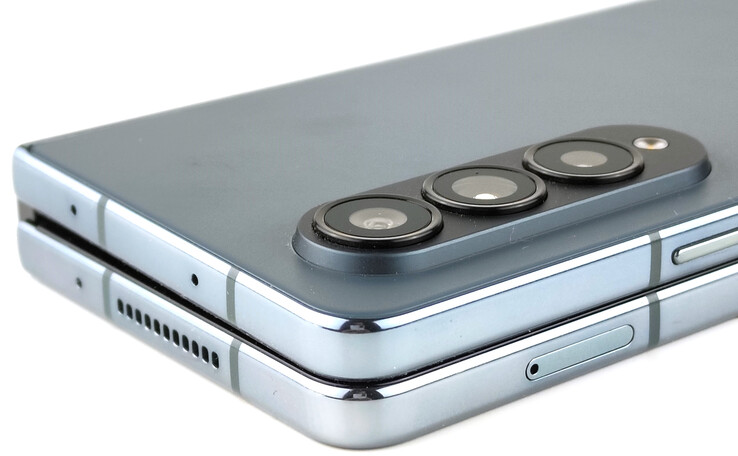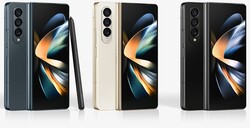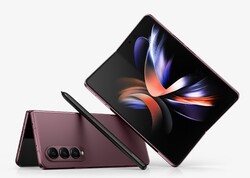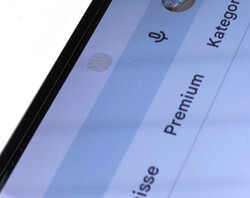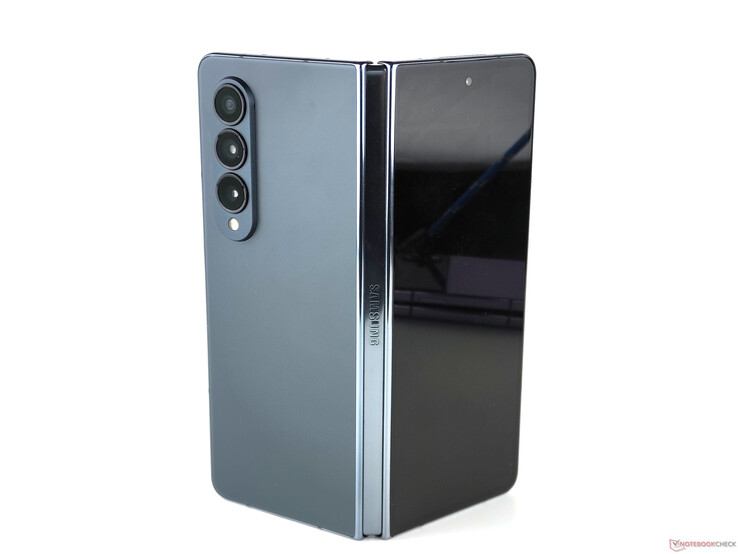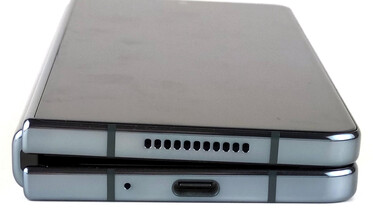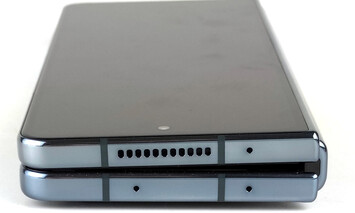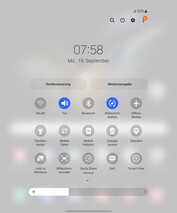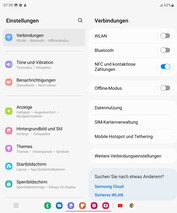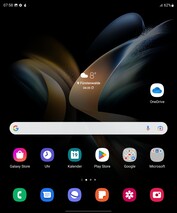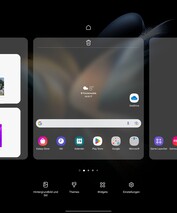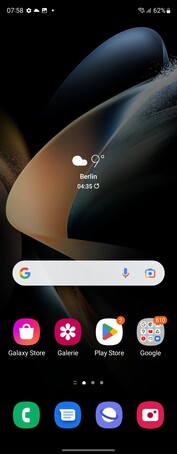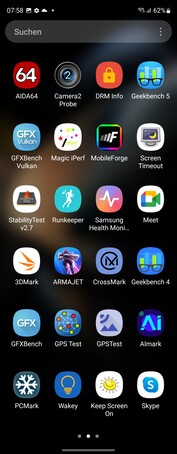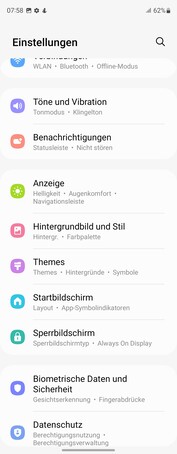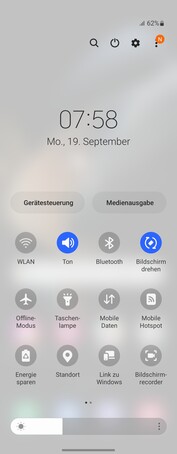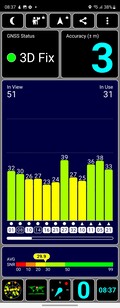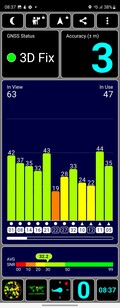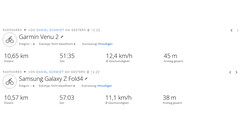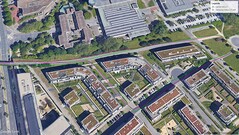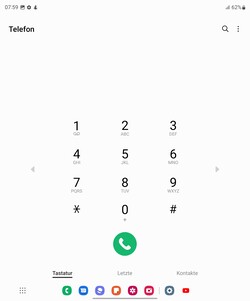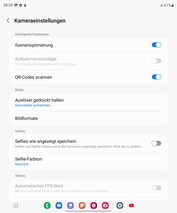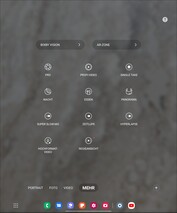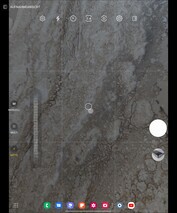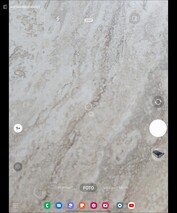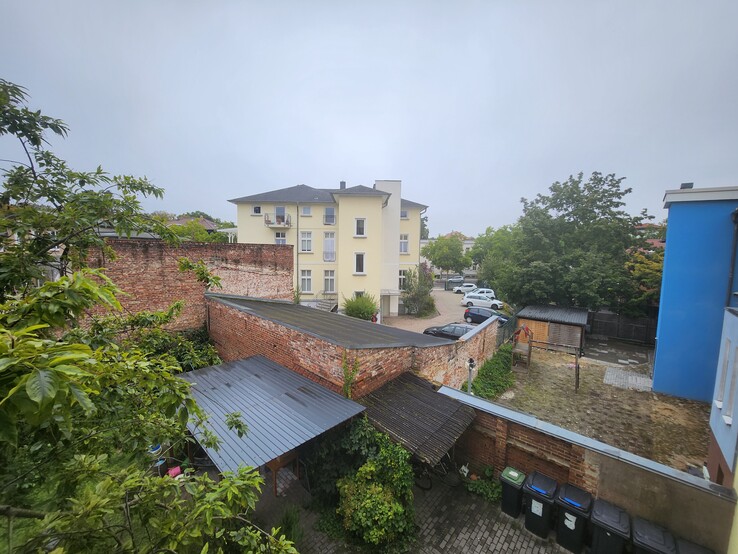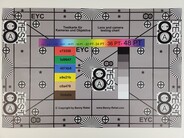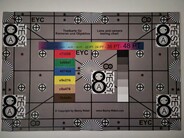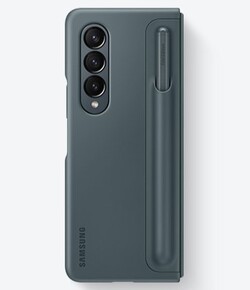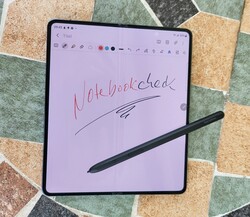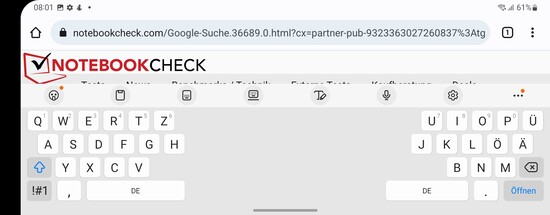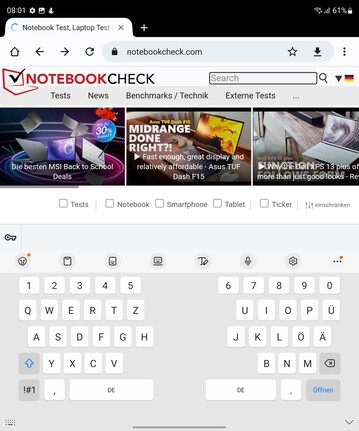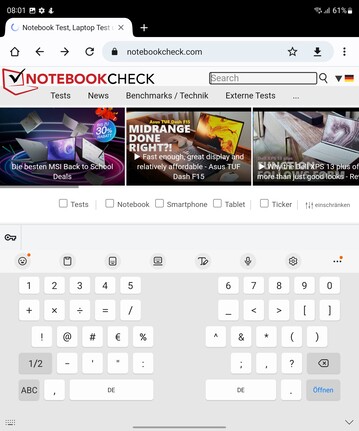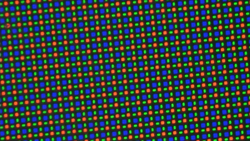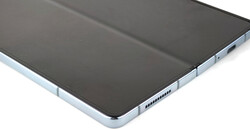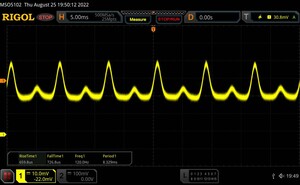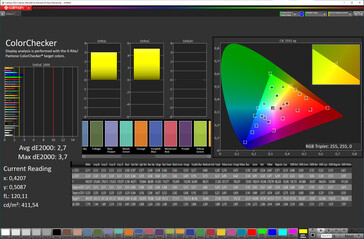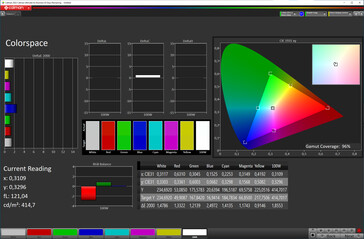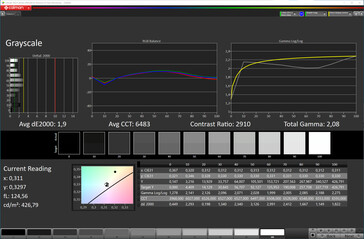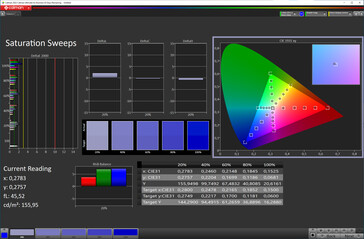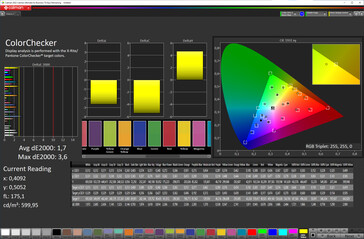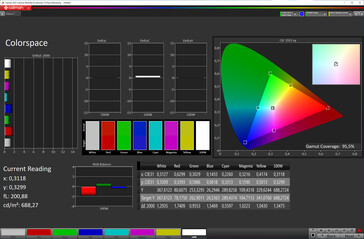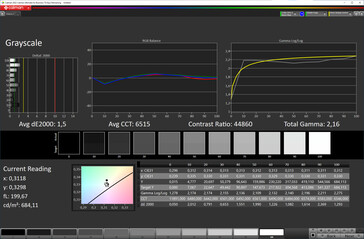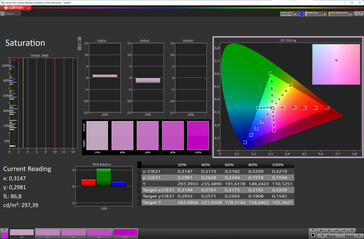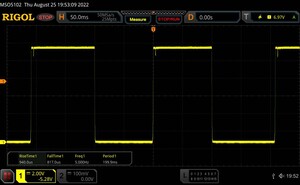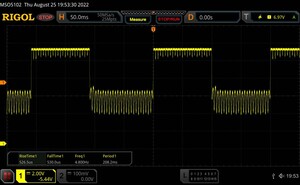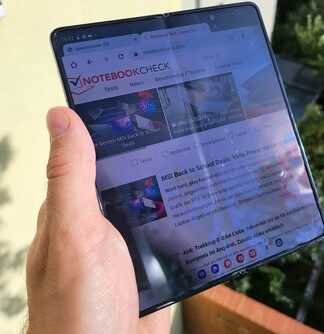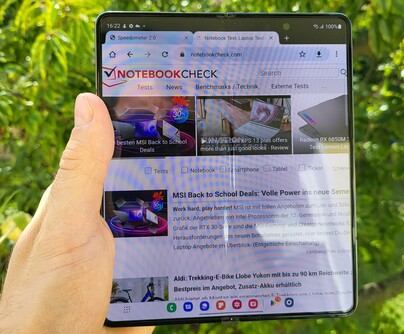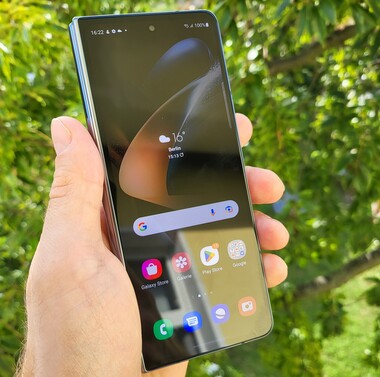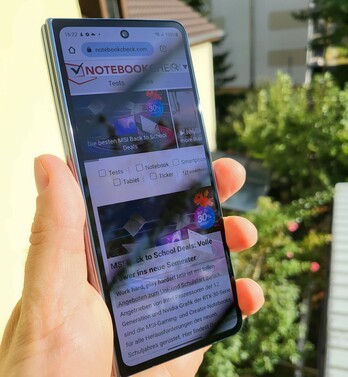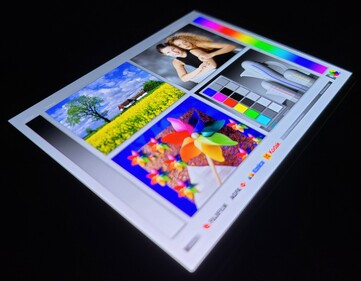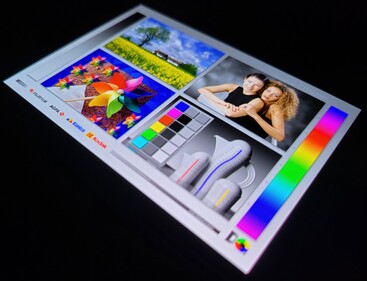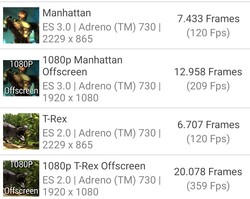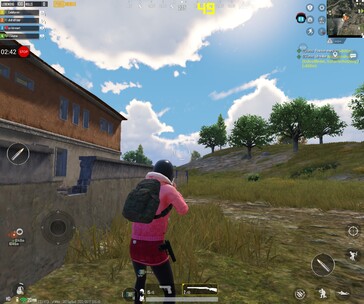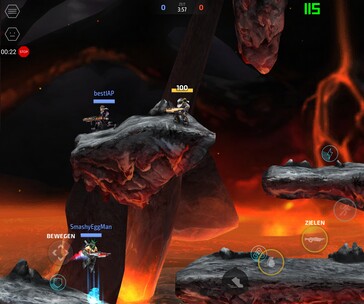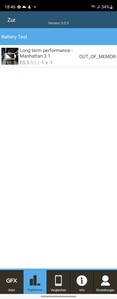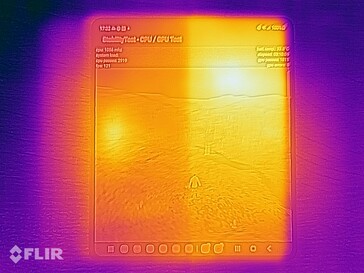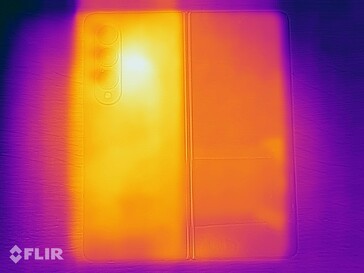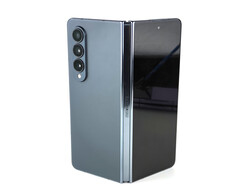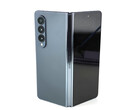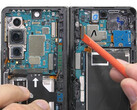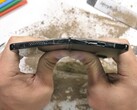Samsung Galaxy Z Fold4 5G review - Improved foldable smartphone shatters dreams of foldables
On paper, the fourth generation of the Galaxy Z Fold is a gentle update of the Galaxy Z Fold3, and there were no changes in the basic concept of the foldable series. In addition to the new 50-MP main camera from the Galaxy S22 Plus, perhaps the largest change is inside the foldable smartphone. Now this contains the relatively efficient Snapdragon 8+ Gen 1, which is supposed to also improve the battery life of the Z Fold4, since the battery capacity remains unchanged at 4,400 mAh.
In terms of the display, there are also only small adjustments in the large foldable smartphone. The main screen continues to measure 7.6 inch, but it now has a 21.6:18 format, making the case slightly wider in unfolded state. The reason for this is the 6.2-inch front display, which now offers a slightly more user-friendly format at 23.1:9, appearing less tall than the Fold3 before it.
This review will clarify how the Galaxy Z Fold4 fares in everyday operation and whether an upgrade from the predecessor is worthwhile.
Possible competitors in Comparison
Rating | Date | Model | Weight | Drive | Size | Resolution | Price |
|---|---|---|---|---|---|---|---|
| 89.8 % v7 (old) | 10 / 2022 | Samsung Galaxy Z Fold4 5G SD 8+ Gen 1, Adreno 730 | 263 g | 256 GB UFS 3.1 Flash | 7.60" | 2176x1812 | |
| 88.9 % v7 (old) | 09 / 2021 | Samsung Galaxy Z Fold3 5G SD 888 5G, Adreno 660 | 271 g | 256 GB UFS 3.1 Flash | 7.60" | 2208x1768 | |
| 84.3 % v7 (old) | 02 / 2022 | Microsoft Surface Duo 2 SD 888 5G, Adreno 660 | 284 g | 256 GB UFS 3.1 Flash | 8.30" | 2688x1892 | |
| 86.9 % v7 (old) | 08 / 2022 | Vivo X Fold SD 8 Gen 1, Adreno 730 | 311 g | 256 GB UFS 3.1 Flash | 8.03" | 2160x1916 | |
| 89.4 % v7 (old) | 03 / 2022 | Samsung Galaxy S22 Ultra 5G Exynos 2200, Xclipse 920 | 228 g | 128 GB UFS 3.1 Flash | 6.80" | 3088x1440 | |
| 88.8 % v7 (old) | 09 / 2022 | Xiaomi 12S Ultra SD 8+ Gen 1, Adreno 730 | 225 g | 256 GB UFS 3.1 Flash | 6.73" | 3200x1440 | |
| 84.1 % v7 (old) | 09 / 2022 | Huawei Mate Xs 2 SD 888 4G, Adreno 660 | 255 g | 512 GB UFS 3.1 Flash | 7.80" | 2480x2220 |
Case - Samsung smartphone with UDC
At first glance, the Z Fold4 looks hardly any different than its predecessor. However, the newly designed hinge of the foldable smartphone reduces the weight minimally to 263 grams (~9.28 oz), and it also allows Samsung to keep the IPX8-certified case slightly slimmer. But at almost 16 mm (~0.63 in), the Fold4 is still significantly thicker than a Xiaomi Mix Fold 2 at 11 mm (~0.43 in). There is also still no integrated S Pen slot as in the Galaxy S22 Ultra.
The workmanship and haptics of the Fold4 are at a very high level. Compared to the Fold3, the slightly edgy transition between the hinge and glass elements was improved, but it is still noticeable in the current generation of the foldable. Unfolding the Fold4 is very easy and feels very high-quality. In the Flex mode, you can adjust it to any variable angle between 75 and 115 degrees.
While users still shouldn't mistreat the inner display of the foldable with pointy objects such as keys, with the fourth generation of the Fold series, Samsung promises more robustness. While it still has the Armor aluminum frame known from the predecessor and the Gorilla Glas Victus+ in the front and back, the flexible dynamic AMOLED panel is now also covered by a newly developed ultra-thin glass layer, which according to the manufacturer is supposed to be up to 45% more robust. With its new mosaic pattern, the under-display camera (UDC) of the Fold4 looks less annoying than that of the predecessor, but it is still visible. Looking at the center of the screen, it is well integrated into the image display, but when you look at it closely, the area with the thinner subpixels is easily noticeable, particularly with a white background. While this solution is more discrete compared to a punch hole, an even thicker pixel grid above the camera would have been better for the OLED panel.
Compared to the Fold3, the bezels around the display have become slightly slimmer. The display-to-surface ratio of the large 7.6-inch panel is a very efficient 90.9%. The Z Fold3 "only" reached 88.9% here, which was still very good.
Equipment - Galaxy Z Fold4 with UWB
You can purchase the Galaxy Z Fold4 with either 256 GB or 512 GB of UFS 3.1 storage and 12 GB of DDR5-RAM. You can also get a 1-TB version exclusively from Samsung's online shop. The equipment of the foldable smartphone is very extensive, but you can also expect this for an MSRP of 1,799 Euros (~$1765).
Included are an always-on function, Miracast, the Ultra-Wideband Technology (UWB), NFC, and with USB 3.2 (Gen1), also a fast standard with a high data transfer rates and the option for wired display output (UHD at 60 fps via DisplayPort) to HDMI and DisplayPort-capable devices. USB-OTG for a quick connection of external accessories is also supported by the Fold4.
Unfortunately, the Samsung foldable lacks classic equipment features such as a status LED, the option to expand the storage via microSD cards, or a 3.5-mm audio port.
Software - Samsung Smartphone with Android 12L
With Android 12L, the Galaxy Z Fold4 uses a version of the Linux Kernel based operating system that is optimized for large displays. In the best case, the 2022 foldable smartphone from Samsung will still get Android 16, since the Galaxy Z family will get up to four generations of OS upgrades and security updates for five years. At the level of July 2022, the latter are not very current anymore at the time of this test. Samsung also protects its foldable with the Knox Vault platform, consisting of a secure processor unit that isolates sensible data such as passwords and biometric information from the main operating system.
As customary, Samsung combines the Android operating system with its in-house OneUI user interface version 4.1.1, which now offers a task bar known from Windows 11. In addition, there are new swipe gestures to split the display into two windows or change full-screen apps into adjustable popups. But despite the new task bar, Samsung DeX with the desktop-like user interface continues to be available.
Communication and GNSS - Galaxy phone with 5G
Although the foldable smartphone from Samsung supports the Wi-Fi 6E WLAN standard, it is only able to communicate with the 2.4 and 5.0 GHz bands of our Asus ROG Rapture GT-AXE11000 reference router. On the other hand, the transfer rates of about 900 Mbit/s are very stable. Yet much higher speeds should (theoretically) be possible in the 6-GHz frequency band.
For mobile connections, the Samsung smartphone supports all the current mobile communication standards, including 5G. Like its predecessor before, the Galaxy Z Fold4 doesn't support the mmWave in Germany, which should allow data rates of up to 70 Gbit/s in theory. However, the slightly slower 5G-Sub6 is still significantly faster at up to 5 Gbit/s than using the 4G frequencies. The foldable also supports a wide selection here, and all the necessary LTE bands in the German-language countries are supported.
| Networking | |
| iperf3 receive AXE11000 | |
| Microsoft Surface Duo 2 | |
| Xiaomi 12S Ultra | |
| Vivo X Fold | |
| Samsung Galaxy Z Fold4 5G | |
| Average of class Smartphone (52 - 1857, n=182, last 2 years) | |
| Samsung Galaxy S22 Ultra 5G | |
| Huawei Mate Xs 2 | |
| iperf3 transmit AXE11000 | |
| Microsoft Surface Duo 2 | |
| Xiaomi 12S Ultra | |
| Samsung Galaxy Z Fold4 5G | |
| Vivo X Fold | |
| Huawei Mate Xs 2 | |
| Average of class Smartphone (49.8 - 1828, n=182, last 2 years) | |
| Samsung Galaxy S22 Ultra 5G | |
| iperf3 transmit AX12 | |
| Samsung Galaxy Z Fold3 5G | |
| iperf3 receive AX12 | |
| Samsung Galaxy Z Fold3 5G | |
The wide range of GNSS support of the foldable smartphone allows the satfix to succeed very quickly even indoors. The location is determined via GPS (L1, L5), GLONASS, BeiDou (B1, B2), and Galileo (E1, E5), as well as SBAS. In order to evaluate the locating capabilities in practice, we record a route for comparison with the Garmin Venu 2.
The deviations in our recorded route are small. The detailed route of the GPS recording shows only smaller inaccuracies of the Fold4, but those shouldn't stand in the way of even exact navigation tasks.
Telephone Functions and Voice Quality - Galaxy Z Fold4 with dual-SIM support
Thanks to its dual-SIM functionality, the Galaxy Z Fold4 supports two Nano SIM cards, as well as VoLTE and WLAN calling. Instead of the SIM cards, you can also use one or two eSIMs simultaneously.
In quiet surroundings, the voice quality is very attractive, and the speaker mode also allows clearly understandable communication with your conversation partner during video calls. Even though the voices of the conversation partners sound fairly natural using the speaker, the Fold4 is very quiet in loud surroundings.
Cameras - Samsung smartphone with triple cam system
Friends of selfies can even have three times the fun with the Galaxy Z Fold4 – at least in theory. Underneath the main display, Samsung has hidden an under-display camera with 4 MP, which allows taking solid pictures, but the results still aren't very good. The results are better with the 10-MP punch-hole lens of the exterior display. In good light conditions, it succeeds in taking contrast-rich selfies with a decent illumination. However, those who want to get the best results will want to use the main camera in the unfolded state, looking at the front panel as the view finder.
The new 50-MP main camera is based on the ISOCELL GN5 sensor from the Samsung Galaxy S22 (Plus). The 1/1.57-inch Samsung sensor impresses with attractive colors and a solid sharpness in daylight conditions. However, particularly the dynamic and richness in details don't range at the flagship level. We also aren't very impressed by the sensor sensitivity under bad light conditions. In this regard, there has to be a larger improvement with the next smartphone generation.
In addition, the triple camera system includes a new 10-MP camera with OIS and lossless 3x zoom and a 12-MP lens for ultrawide angle recordings. The latter should be identical to that in the Fold3, which is unfortunate, since we would have liked a better ultrawide angle sensor here as well, considering the price level. The tele lens with its nominally low resolution takes decent pictures, but the edges appear blurry, offering only few details already at a 5x hybrid zoom.
You can record videos in 8K resolution at 24 fps or in 4K at 60 fps. You can also switch between the lenses while recording a video. The color temperatures of the main, wide angle, and tele camera are well-adjusted to each other.
Image comparison
Choose a scene and navigate within the first image. One click changes the position on touchscreens. One click on the zoomed-in image opens the original in a new window. The first image shows the scaled photograph of the test device.
Wide angleWide angleLow lightUltrawide angle5x zoomSamsung doesn't cooperate with a traditional camera manufacturer for camera calibration, unlike other smartphone manufacturers. However, the colors are still reproduced well, without objects looking too pale. The color accuracy we measure under controlled light conditions only shows two outliers (>15). The analysis with the ColorChecker Passport compared to the actual reference colors shows some room for improvement particularly in green and brown color tones, as well as the grayscale.
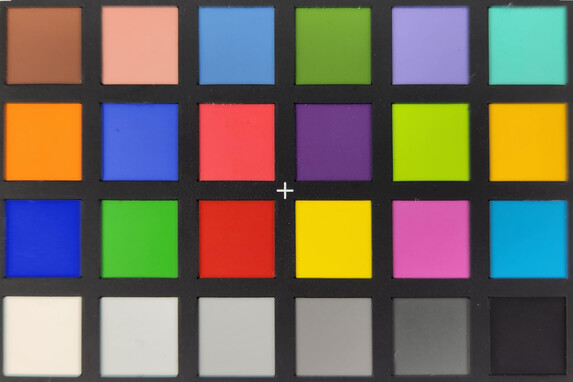
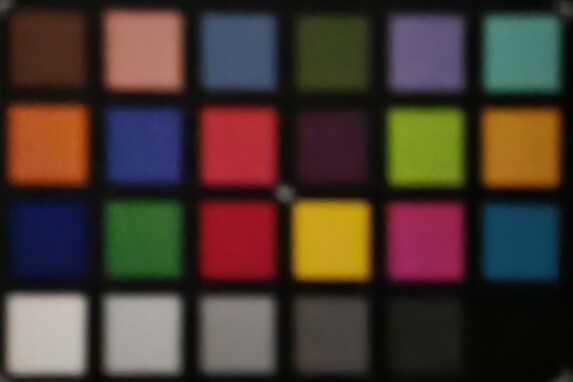
Accessories and Warranty - Samsung smartphone without a charger
The box of the Samsung Galaxy Z Fold4 doesn't include a charger, but there is a data or charging cable (USB-C to USB-C) and a SIM tool. Optionally, Samsung also offers the S Pen Fold Edition and a standing cover together with the S Pen, as well as the S Pen Pro.
Samsung offers a warranty of 24 months for its smartphone. When you purchase the foldable, Samsung Care+ is again included for a year, so it is limited to damages occurring within this period. Some specific accidental damage such as broken displays and damage from liquids is covered. According to the warranty conditions, there is a deductible of 130 Euros (~$128) in the case of accidental damage.
Input Devices and Operation - Galaxy smartphone with FaceUnlock
The exterior display, which is protected by Corning Gorilla Glas Victus+, is very responsive and relatively safe from scratches. The new format ratio makes typing slightly more comfortable but is still no game changer in terms of operation or when typing longer texts. One advantage of the Fold series from the Korean manufacturer compared to the competitors is the Flex mode, which is again very stable and functional. The Flex mode allows you for example to record video calls or take pictures with a long exposure without having to use a tripod, by placing one side of the Fold4 on a flat surface, while recording with the camera in the other side.
The main display inside the Fold4 is covered by an ultrathin, foldable glass layer, which is covered by a permanent protective foil. Even though this doesn't feel as hard as glass, it still doesn't appear cheap and should also last for a longer time of usage without showing any signs of wearing out. For more than 12 months, a Galaxy Z Fold3 has been running through an endurance test in our lab without the foil becoming loose or discolored. Despite S Pen usage, there are also no deep scratches.
Thanks to the refresh rate of 120 Hz, changing images or scrolling websites are displayed very smoothly. However, before purchasing a Fold4, any potential buyer should be aware that the 7.6-inch display with its unusual side ratio is less suited for social media apps. Also, mobile pages in the browser often appear with a strange sizing. Productive work in split screen mode also takes some time of getting used to, since the almost square screen area will be split into two very tall work areas.
The fingerprint sensor integrated into the power button unlocks the Samsung smartphone very reliably and quickly. The FaceUnlock function via the front camera, which is based on very simple 2D face recognition, is similarly reliable in everyday operation, although it is not as safe. The UDC can also be used for this kind of unlocking.
The Fold4 supports two devices for pen input: the S Pen Pro and the S Pen Fold Edition. Unfortunately, the support continues to be limited to only the main display, so that practical functions such as writing a quick note in stand-by operation with the Galaxy S22 Ultra are not supported here. Except for the gestures and remote control functions, all the usual features are available, and the S Pen ensures an accurate input on the responsive OLED display.
Display - Galaxy Z Fold4 with AMOLED
The main reason to decide for purchasing a Galaxy Z Fold4 would probably be the large, 7.6-inch dynamic AMOLED display with a dynamic refresh rate of 1 to 120 Hz. However, the main display uses a minimum refresh rate of 24 Hz during our testing period. The "DRM Info" app reports a range between 10 and 120 Hz. The resolution of 2,176 x 1,812 pixels results in a fairly square 21.6:18 format. Compared to the predecessor, the maximum brightness has again slightly increased.
With a full white image display, we measure a maximum brightness of 950 cd/m². In the APL18 measurement with light and dark image areas, it is 1,226 cd/m² in the center of the screen. This makes the HDR10+ panel very well suited for the reproduction of contents with a large dynamic range. Although a Galaxy S22 Ultra can reach an even higher brightness of almost 1,800 cd/m², the Fold4 still performs at the flagship level of other manufacturers here.
The seam in the folding area is still easily noticeable, but only if you look at the panel from a side angle. We do not notice any visible advantage compared to the predecessor in this regard.
Outside Display
The front panel measures 6.2 inches in the diagonal. With a refresh rate of 48 to 120 Hz, it is slightly less dynamic than the main display. The 2,316 x 904 pixels result in a tall, stretched 23.1:9 format and a slightly higher sharpness level at 402 ppi. In terms of brightness, the two dynamic AMOLED displays perform at a similar level. At 1,430 cd/m², the small exterior panel gets slightly brighter in the APL18 measurement, but we measure an almost identical maximum brightness of 944 cd/m² with a full white display.
Pulse-width Modulation
Due to the OLED technology, both panels of the foldable are not free of display flickering. We measure a low PWM frequency of 120 Hz at minimum brightness. When the brightness of both displays is increased, the flickering levels out at a constant 240 Hz. For sensitive users, such low frequencies can become problematic, even though the constant flickering works similarly as DC Dimming. In our Temporal Dithering test, the Fold4 doesn't show any conspicuous behavior. In this test, we look at the display with a microscope playing a 240-fps slow motion video at full brightness with a gray background.
| |||||||||||||||||||||||||
Brightness Distribution: 98 %
Center on Battery: 930 cd/m²
Contrast: ∞:1 (Black: 0 cd/m²)
ΔE ColorChecker Calman: 2.7 | ∀{0.5-29.43 Ø4.78}
ΔE Greyscale Calman: 1.9 | ∀{0.09-98 Ø5}
96% sRGB (Calman 2D)
Gamma: 2.08
CCT: 6483 K
| |||||||||||||||||||||||||
Brightness Distribution: 96 %
Center on Battery: 913 cd/m²
Contrast: ∞:1 (Black: 0 cd/m²)
ΔE ColorChecker Calman: 1.7 | ∀{0.5-29.43 Ø4.78}
ΔE Greyscale Calman: 1.5 | ∀{0.09-98 Ø5}
95.5% sRGB (Calman 2D)
Gamma: 2.16
CCT: 6515 K
| Samsung Galaxy Z Fold4 5G Dynamic AMOLED, 2176x1812, 7.6" | Samsung Galaxy Z Fold3 5G Dynamic AMOLED, 2208x1768, 7.6" | Microsoft Surface Duo 2 AMOLED, 2688x1892, 8.3" | Vivo X Fold AMOLED, 2160x1916, 8" | Samsung Galaxy S22 Ultra 5G Dynamic AMOLED, 3088x1440, 6.8" | Xiaomi 12S Ultra OLED, 3200x1440, 6.7" | Huawei Mate Xs 2 OLED, 2480x2220, 7.8" | |
|---|---|---|---|---|---|---|---|
| Screen | -30% | -48% | -5% | 21% | 1% | -58% | |
| Brightness middle (cd/m²) | 913 | 808 -12% | 663 -27% | 730 -20% | 1077 18% | 831 -9% | 763 -16% |
| Brightness (cd/m²) | 929 | 820 -12% | 661 -29% | 724 -22% | 1093 18% | 807 -13% | 769 -17% |
| Brightness Distribution (%) | 96 | 97 1% | 98 2% | 95 -1% | 97 1% | 91 -5% | 95 -1% |
| Black Level * (cd/m²) | |||||||
| Colorchecker dE 2000 * | 1.7 | 2.9 -71% | 3.5 -106% | 1.66 2% | 1.2 29% | 1.03 39% | 2.8 -65% |
| Colorchecker dE 2000 max. * | 3.6 | 4.2 -17% | 5.3 -47% | 2.92 19% | 2 44% | 3.06 15% | 5.9 -64% |
| Greyscale dE 2000 * | 1.5 | 2.5 -67% | 2.7 -80% | 1.6 -7% | 1.3 13% | 1.8 -20% | 4.3 -187% |
| Gamma | 2.16 102% | 2.01 109% | 1.93 114% | 2.28 96% | 2.37 93% | 2.233 99% | 2.24 98% |
| CCT | 6515 100% | 6359 102% | 6503 100% | 6395 102% | 6526 100% | 6396 102% | 6457 101% |
* ... smaller is better
Screen Flickering / PWM (Pulse-Width Modulation)
| Screen flickering / PWM detected | 120 Hz | ||
The display backlight flickers at 120 Hz (worst case, e.g., utilizing PWM) . The frequency of 120 Hz is very low, so the flickering may cause eyestrain and headaches after extended use. In comparison: 53 % of all tested devices do not use PWM to dim the display. If PWM was detected, an average of 8111 (minimum: 5 - maximum: 343500) Hz was measured. | |||
Series of measurements at fixed zoom level and different brightness settings
The OneUI interface still doesn't offer a lot of adjustment options in terms of the color reproduction. The Fold4 offers two different profiles, but you can only adjust the color temperature in the "Vivid" profile. You cannot adjust separate display parameters such as the saturation according to your own preference.
In our tests with the CalMAN software and a spectral photometer, the 7.6-inch AMOLED panel shows itself as very well calibrated with very low color deviations (in the "Natural" color profile), even if you can still see minimal deviations. The Galaxy foldable still ends up within the target range of <3. Due to the OLED technology where single pixels can be turned off completely, the contrast is very good.
The smaller exterior panel also targets the smaller sRGB color space but is slightly better calibrated with DeltaE deviations <2. However, these differences aren't really noticeable in everyday operation.
Display Response Times
| ↔ Response Time Black to White | ||
|---|---|---|
| 1.76 ms ... rise ↗ and fall ↘ combined | ↗ 0.94 ms rise | |
| ↘ 0.817 ms fall | ||
| The screen shows very fast response rates in our tests and should be very well suited for fast-paced gaming. In comparison, all tested devices range from 0.1 (minimum) to 240 (maximum) ms. » 9 % of all devices are better. This means that the measured response time is better than the average of all tested devices (20.2 ms). | ||
| ↔ Response Time 50% Grey to 80% Grey | ||
| 1.06 ms ... rise ↗ and fall ↘ combined | ↗ 0.5265 ms rise | |
| ↘ 0.53 ms fall | ||
| The screen shows very fast response rates in our tests and should be very well suited for fast-paced gaming. In comparison, all tested devices range from 0.165 (minimum) to 636 (maximum) ms. » 4 % of all devices are better. This means that the measured response time is better than the average of all tested devices (31.6 ms). | ||
With its high brightness, the foldable smartphone from Samsung is very well suited for everyday usage outdoors. However, those who don't use the automatic brightness sensor will only get a brightness of about 420 cd/m² (~720 cd/m² with the "Additional brightness" option) from the panels. In direct sunlight with the corresponding reflections on the surface, the image contents are still readable due to the high contrasts, even if buyers of the Fold4 cannot expect a brightness reserve such as that of a Galaxy S22 Ultra. The protective foil on the main display is slightly more reflective than the Gorilla Glass Victus+ of the exterior panel.
The viewing angle stability of the two AMOLED panels is very good, and you only notice a slight loss in brightness from very steep viewing angles. The colors will still look vibrant and hardly distorted.
Performance - Samsung smartphone with Qualcomm SoC
In contrast to the Galaxy S22 Ultra, buyers of the foldable also get a Qualcomm chipset in Europe. The Snapdragon 8+ Gen1 is supported by 12 GB of LPDDR5 working memory and also contains an Adreno 730.
In our CPU benchmarks, the Galaxy foldable strikes a good figure but still remains slightly behind the Snapdragon 8+ Gen1 competitors. Particularly in the multi-core score of Geekbench, it turns out worse than the Xiaomi 12S Ultra or Asus Zenfone 9.
| UL Procyon AI Inference for Android - Overall Score NNAPI | |
| Samsung Galaxy Z Fold4 5G | |
| Xiaomi 12S Ultra | |
| Average Qualcomm Snapdragon 8+ Gen 1 (3291 - 84787, n=21) | |
| Average of class Smartphone (3769 - 81594, n=139, last 2 years) | |
| Samsung Galaxy S22 Ultra 5G | |
| AImark - Score v2.x | |
| Samsung Galaxy Z Fold3 5G | |
| Microsoft Surface Duo 2 | |
| Xiaomi 12S Ultra | |
| Samsung Galaxy Z Fold4 5G | |
| Average Qualcomm Snapdragon 8+ Gen 1 (1043 - 7865, n=11) | |
| Samsung Galaxy S22 Ultra 5G | |
In the graphics-heavy tests, the Fold4 ends up slightly ahead of the Galaxy S22 Ultra, but the foldable smartphone is still unable to reach the high values of our comparison devices with 1440p resolution and the Adreno 730.
| GFXBench (DX / GLBenchmark) 2.7 | |
| T-Rex Onscreen | |
| Samsung Galaxy Z Fold4 5G | |
| Xiaomi 12S Ultra | |
| Samsung Galaxy S22 Ultra 5G | |
| Samsung Galaxy Z Fold3 5G | |
| Microsoft Surface Duo 2 | |
| 1920x1080 T-Rex Offscreen | |
| Xiaomi 12S Ultra | |
| Samsung Galaxy S22 Ultra 5G | |
| Samsung Galaxy Z Fold4 5G | |
| Microsoft Surface Duo 2 | |
| Samsung Galaxy Z Fold3 5G | |
| GFXBench 3.0 | |
| on screen Manhattan Onscreen OGL | |
| Samsung Galaxy Z Fold4 5G | |
| Samsung Galaxy S22 Ultra 5G | |
| Xiaomi 12S Ultra | |
| Microsoft Surface Duo 2 | |
| Samsung Galaxy Z Fold3 5G | |
| 1920x1080 1080p Manhattan Offscreen | |
| Xiaomi 12S Ultra | |
| Samsung Galaxy S22 Ultra 5G | |
| Samsung Galaxy Z Fold4 5G | |
| Microsoft Surface Duo 2 | |
| Samsung Galaxy Z Fold3 5G | |
| GFXBench 3.1 | |
| on screen Manhattan ES 3.1 Onscreen | |
| Xiaomi 12S Ultra | |
| Samsung Galaxy Z Fold4 5G | |
| Microsoft Surface Duo 2 | |
| Samsung Galaxy S22 Ultra 5G | |
| Samsung Galaxy Z Fold3 5G | |
| 1920x1080 Manhattan ES 3.1 Offscreen | |
| Xiaomi 12S Ultra | |
| Samsung Galaxy S22 Ultra 5G | |
| Samsung Galaxy Z Fold4 5G | |
| Microsoft Surface Duo 2 | |
| Samsung Galaxy Z Fold3 5G | |
| GFXBench | |
| on screen Car Chase Onscreen | |
| Xiaomi 12S Ultra | |
| Samsung Galaxy Z Fold4 5G | |
| Microsoft Surface Duo 2 | |
| Samsung Galaxy S22 Ultra 5G | |
| Samsung Galaxy Z Fold3 5G | |
| 1920x1080 Car Chase Offscreen | |
| Xiaomi 12S Ultra | |
| Samsung Galaxy Z Fold4 5G | |
| Samsung Galaxy S22 Ultra 5G | |
| Microsoft Surface Duo 2 | |
| Samsung Galaxy Z Fold3 5G | |
| on screen Aztec Ruins High Tier Onscreen | |
| Samsung Galaxy Z Fold4 5G | |
| Xiaomi 12S Ultra | |
| Microsoft Surface Duo 2 | |
| Vivo X Fold | |
| Samsung Galaxy S22 Ultra 5G | |
| Samsung Galaxy Z Fold3 5G | |
| 2560x1440 Aztec Ruins High Tier Offscreen | |
| Xiaomi 12S Ultra | |
| Samsung Galaxy Z Fold4 5G | |
| Vivo X Fold | |
| Samsung Galaxy S22 Ultra 5G | |
| Microsoft Surface Duo 2 | |
| Samsung Galaxy Z Fold3 5G | |
| on screen Aztec Ruins Normal Tier Onscreen | |
| Xiaomi 12S Ultra | |
| Samsung Galaxy Z Fold4 5G | |
| Microsoft Surface Duo 2 | |
| Vivo X Fold | |
| Samsung Galaxy S22 Ultra 5G | |
| Samsung Galaxy Z Fold3 5G | |
| 1920x1080 Aztec Ruins Normal Tier Offscreen | |
| Xiaomi 12S Ultra | |
| Vivo X Fold | |
| Samsung Galaxy Z Fold4 5G | |
| Samsung Galaxy S22 Ultra 5G | |
| Microsoft Surface Duo 2 | |
| Samsung Galaxy Z Fold3 5G | |
In the browser benchmarks, the Fold4 impresses with attractive results and a smooth performance when surfing using the Chrome browser. Aside from Internet activities, the Samsung smartphone also offers a high system performance with smooth animations and without any major stutters.
| Jetstream 2 - 2.0 Total Score | |
| Average of class Smartphone (23.8 - 387, n=154, last 2 years) | |
| Samsung Galaxy Z Fold4 5G (Chrome 105) | |
| Average Qualcomm Snapdragon 8+ Gen 1 (76.2 - 204, n=23) | |
| Xiaomi 12S Ultra (Chrome 104) | |
| Samsung Galaxy S22 Ultra 5G (Chrome 99) | |
| Samsung Galaxy Z Fold3 5G (Chrome 92) | |
| Speedometer 2.0 - Result 2.0 | |
| Average of class Smartphone (15.2 - 643, n=128, last 2 years) | |
| Average Qualcomm Snapdragon 8+ Gen 1 (69.1 - 196, n=18) | |
| Samsung Galaxy Z Fold4 5G (Chrome 105) | |
| Samsung Galaxy S22 Ultra 5G (Chrome 99) | |
| Xiaomi 12S Ultra (Chrome 104) | |
| Samsung Galaxy Z Fold3 5G (Chrome 92) | |
| WebXPRT 4 - Overall | |
| Average of class Smartphone (27 - 306, n=148, last 2 years) | |
| Samsung Galaxy Z Fold4 5G (Chrome 105) | |
| Average Qualcomm Snapdragon 8+ Gen 1 (69 - 159, n=21) | |
| Xiaomi 12S Ultra (Chrome 104) | |
| WebXPRT 3 - Overall | |
| Average of class Smartphone (38 - 380, n=35, last 2 years) | |
| Samsung Galaxy Z Fold4 5G (Chrome 105) | |
| Microsoft Surface Duo 2 (Chrome 97) | |
| Average Qualcomm Snapdragon 8+ Gen 1 (106 - 224, n=14) | |
| Samsung Galaxy Z Fold3 5G (Chrome 92) | |
| Xiaomi 12S Ultra (Chrome 104) | |
| Samsung Galaxy S22 Ultra 5G (Chrome 99) | |
| Octane V2 - Total Score | |
| Samsung Galaxy Z Fold4 5G (Chrome 105) | |
| Average of class Smartphone (2228 - 121337, n=201, last 2 years) | |
| Microsoft Surface Duo 2 | |
| Average Qualcomm Snapdragon 8+ Gen 1 (17622 - 61536, n=24) | |
| Xiaomi 12S Ultra (Chrome 104) | |
| Samsung Galaxy S22 Ultra 5G (Chrome 99) | |
| Samsung Galaxy Z Fold3 5G (Chrome 92) | |
| Mozilla Kraken 1.1 - Total | |
| Samsung Galaxy S22 Ultra 5G (Chrome 99) | |
| Average of class Smartphone (257 - 28190, n=156, last 2 years) | |
| Xiaomi 12S Ultra (Chrome 104) | |
| Average Qualcomm Snapdragon 8+ Gen 1 (665 - 1707, n=22) | |
| Samsung Galaxy Z Fold3 5G (Chrome 92) | |
| Microsoft Surface Duo 2 (Chrome 97) | |
| Samsung Galaxy Z Fold4 5G (Chrome 105) | |
* ... smaller is better
The nominally fast UFS 3.1 storage used in the Galaxy smartphone confirms its high performance capabilities also in the AndroBench benchmark. With write rates above 1,250 Mbit/s, the Fold4 performs significantly better than the predecessor. In our experience, the higher-priced versions with 512 GB and 1 TB should even be slightly faster.
| Samsung Galaxy Z Fold4 5G | Samsung Galaxy Z Fold3 5G | Microsoft Surface Duo 2 | Vivo X Fold | Samsung Galaxy S22 Ultra 5G | Xiaomi 12S Ultra | Average 256 GB UFS 3.1 Flash | Average of class Smartphone | |
|---|---|---|---|---|---|---|---|---|
| AndroBench 3-5 | -23% | -8% | 10% | -6% | 26% | 0% | 21% | |
| Sequential Read 256KB (MB/s) | 1854.98 | 1934 4% | 1818 -2% | 1850.6 0% | 1653 -11% | 1963.45 6% | 1757 ? -5% | 2223 ? 20% |
| Sequential Write 256KB (MB/s) | 1251.57 | 790 -37% | 754 -40% | 1405 12% | 1074 -14% | 1475.43 18% | 1204 ? -4% | 1838 ? 47% |
| Random Read 4KB (MB/s) | 321.87 | 215.5 -33% | 287.1 -11% | 293.4 -9% | 322.3 0% | 309.21 -4% | 287 ? -11% | 295 ? -8% |
| Random Write 4KB (MB/s) | 265.9 | 195.7 -26% | 324.7 22% | 358.1 35% | 273.1 3% | 489.58 84% | 318 ? 20% | 335 ? 26% |
Games - Galaxy Z Fold4 reaches 120 fps
We take a closer look at the gaming performance with the GameBench app. Both of our test games use the full area of the 7.6-inch display. PUBG Mobile can be played at low detail settings at a frame rate of almost 60 fps, and at the highest detail level until now (UHD), the average frame rate is 40 fps. As expected, the Armajet arena shooter, which supports 144 fps in theory, turns out even smoother. At 118 fps, the Fold4 performance is above average here. We don't see a real drop in the frame rate here - unlike in other smartphones with the Snapdragon 8+ Gen1.
Emissions - Samsung smartphone stays fairly cool
Temperatures
Even though the Samsung foldable gets warm in our load scenario, it doesn't get uncomfortably hot. It will be interesting to see, whether the low heat development still has a negative effect on the performance capabilities of the Qualcom SoC, as in the Asus Zenfone 9 or Xiaomi 12S Ultra.
We evaluate the behavior of the Snapdragon 8+ Gen 1 under constant load with the GFXBench battery test. Even though the test is completed successfully, we are unable to display the results without the app closing. We have better success with the 3DMark stress tests, where we get values between 54 and 62%, attesting the Fold4 with relatively inconsistent performance capabilities. However, when we look at the competitors that are not foldable, we see similar problems with the throttling, even though the Samsung foldable already reduces its performance very early in the test.
(+) The maximum temperature on the upper side is 34 °C / 93 F, compared to the average of 35.2 °C / 95 F, ranging from 21.9 to 247 °C for the class Smartphone.
(+) The bottom heats up to a maximum of 33.4 °C / 92 F, compared to the average of 34 °C / 93 F
(+) In idle usage, the average temperature for the upper side is 24.4 °C / 76 F, compared to the device average of 32.9 °C / 91 F.
3DMark Wild Life Stress Test
| 3DMark | |
| Wild Life Stress Test Stability | |
| Microsoft Surface Duo 2 | |
| Samsung Galaxy Z Fold3 5G | |
| Samsung Galaxy S22 Ultra 5G | |
| Xiaomi 12S Ultra | |
| Samsung Galaxy Z Fold4 5G | |
| Wild Life Extreme Stress Test | |
| Samsung Galaxy Z Fold3 5G | |
| Xiaomi 12S Ultra | |
| Microsoft Surface Duo 2 | |
| Samsung Galaxy Z Fold4 5G | |
| Samsung Galaxy S22 Ultra 5G | |
Speakers
The dual-speaker system of the Fold4 is probably the same as in the Fold3, but this isn't a bad thing, since the sound qualities are very impressive, considering the slim case of the foldable. The sound reproduction is linear and even offers a fair amount of bass. We really like the sound experience, despite the super high tones having slightly less presence.
You can connect wired headphones or external speakers using the USB-C connection. Those who prefer Bluetooth for wireless sound output can use the SBC, AAC, aptX, and LDAC audio codecs. However, Qualcomm's aptX HD and aptX Adaptive are not supported.
Samsung Galaxy Z Fold4 5G audio analysis
(+) | speakers can play relatively loud (87.4 dB)
Bass 100 - 315 Hz
(-) | nearly no bass - on average 20.6% lower than median
(±) | linearity of bass is average (9.7% delta to prev. frequency)
Mids 400 - 2000 Hz
(+) | balanced mids - only 4% away from median
(+) | mids are linear (3.9% delta to prev. frequency)
Highs 2 - 16 kHz
(±) | higher highs - on average 6% higher than median
(+) | highs are linear (3.5% delta to prev. frequency)
Overall 100 - 16.000 Hz
(±) | linearity of overall sound is average (16.3% difference to median)
Compared to same class
» 6% of all tested devices in this class were better, 5% similar, 89% worse
» The best had a delta of 11%, average was 35%, worst was 134%
Compared to all devices tested
» 26% of all tested devices were better, 6% similar, 69% worse
» The best had a delta of 4%, average was 24%, worst was 134%
Samsung Galaxy Z Fold3 5G audio analysis
(+) | speakers can play relatively loud (88.7 dB)
Bass 100 - 315 Hz
(-) | nearly no bass - on average 23.4% lower than median
(±) | linearity of bass is average (10.5% delta to prev. frequency)
Mids 400 - 2000 Hz
(+) | balanced mids - only 3.8% away from median
(+) | mids are linear (4.8% delta to prev. frequency)
Highs 2 - 16 kHz
(+) | balanced highs - only 3.2% away from median
(+) | highs are linear (4.2% delta to prev. frequency)
Overall 100 - 16.000 Hz
(+) | overall sound is linear (14.8% difference to median)
Compared to same class
» 2% of all tested devices in this class were better, 2% similar, 96% worse
» The best had a delta of 11%, average was 35%, worst was 134%
Compared to all devices tested
» 19% of all tested devices were better, 4% similar, 77% worse
» The best had a delta of 4%, average was 24%, worst was 134%
Battery Life - Galaxy Z Fold4 with a low consumption
Power Consumption
We measure the power consumption of the Fold4 with the large main display. During idle operation as well as under load, the foldable has a similar power consumption as the Xiaomi 12S Ultra, which also uses the Snapdragon 8+ Gen1. During the GFXBench benchmark, the power consumption drops considerably, which is (probably) due to the throttling.
The Galaxy Foldable uses a "Super Fast Charging" technology, which is limited to 25 watts for wired charging and 15 watts for wireless charging, similar to the predecessor. Wireless PowerShare at 5 watts is also included. Using the corresponding Samsung charger (25 watts), it takes almost 2 hours to completely recharge the smartphone.
| Off / Standby | |
| Idle | |
| Load |
|
Key:
min: | |
| Samsung Galaxy Z Fold4 5G 4400 mAh | Samsung Galaxy Z Fold3 5G 4400 mAh | Microsoft Surface Duo 2 4449 mAh | Samsung Galaxy S22 Ultra 5G 5000 mAh | Xiaomi 12S Ultra 4860 mAh | Average Qualcomm Snapdragon 8+ Gen 1 | Average of class Smartphone | |
|---|---|---|---|---|---|---|---|
| Power Consumption | -18% | -88% | -16% | 1% | -48% | -44% | |
| Idle Minimum * (Watt) | 0.89 | 1.02 -15% | 1.55 -74% | 0.58 35% | 0.9 -1% | 1.006 ? -13% | 0.848 ? 5% |
| Idle Average * (Watt) | 0.96 | 1.18 -23% | 2.43 -153% | 0.71 26% | 1 -4% | 1.834 ? -91% | 1.434 ? -49% |
| Idle Maximum * (Watt) | 1.13 | 1.27 -12% | 2.52 -123% | 1.16 -3% | 1.2 -6% | 1.984 ? -76% | 1.618 ? -43% |
| Load Average * (Watt) | 4.32 | 5.25 -22% | 6.7 -55% | 7.07 -64% | 3.5 19% | 5.68 ? -31% | 7.01 ? -62% |
| Load Maximum * (Watt) | 6.56 | 7.74 -18% | 8.74 -33% | 11.32 -73% | 6.9 -5% | 8.44 ? -29% | 11.3 ? -72% |
* ... smaller is better
Power Consumption: Geekbench (150 cd/m²)
Power Consumption: GFXBench (150 cd/m²)
Battery Life
The battery of the Galaxy Z Fold4 offers a capacity of 4,400 mAh, so nothing has changed compared to the predecessor here. At an adjusted display brightness of 150 cd/m², the battery life is at a slightly better level. Our comparison devices are best compared at the same brightness. With 11 hours in our WLAN test and 19 hours in the video test, the foldable places just ahead of the Fold3.
If we use the smaller exterior display, we end up at 711 minutes in the WLAN test, which is only about an hour longer than with the significantly larger main display. Together with the fairly low idle runtime, this points at a relatively power-hungry WLAN module in the Fold4.
Note: The battery life values were measured for a decrease of the battery level from 100 to 4%. At that point, the Fold4 enters into a power-saving mode, and all the apps are automatically closed.
| Samsung Galaxy Z Fold4 5G 4400 mAh | Samsung Galaxy Z Fold3 5G 4400 mAh | Microsoft Surface Duo 2 4449 mAh | Vivo X Fold 4600 mAh | Samsung Galaxy S22 Ultra 5G 5000 mAh | Xiaomi 12S Ultra 4860 mAh | |
|---|---|---|---|---|---|---|
| Battery runtime | 4% | -34% | 5% | 36% | 29% | |
| Reader / Idle (h) | 21.3 | 21 -1% | 32.9 54% | 29.4 38% | ||
| H.264 (h) | 19.2 | 16.7 -13% | 18 -6% | 18.5 -4% | ||
| WiFi v1.3 (h) | 11.1 | 10.2 -8% | 7.3 -34% | 11.6 5% | 14.1 27% | 15.9 43% |
| Load (h) | 4 | 5.5 38% | 6.8 70% | 5.5 38% |
Pros
Cons
Verdict on the Samsung Galaxy Z Fold4
With the newest version of the Galaxy Z Fold series, the Korean manufacturer again succeeded in creating a powerful foldable smartphone. Compared to the Fold3, the Fold4 offers several improvements, but Samsung remains behind our expectations with its foldable series this year. The Samsung smartphone looks just like the predecessor and also feels very similar. So with the 2022 Fold model the latest, we get the impression of a stagnation for the foldables from the Korean manufacturer, since the following complaints about the predecessor weren't really addressed:
The very visible UD camera of Fold3 is again used almost unchanged, although some other manufacturers such as Xiaomi with the Mix 4 or ZTE with the Axon 40 Ultra have already shown that it can be done better. The display seam of the Fold4 also still looks very present, even though Vivo, for example, hardly shows any seam in the folding area of its X Fold. Even though Samsung has reduced the case thickness and weight of Fold4 slightly, Xiaomi already shows impressively this year with the Mi Fold 2 where this development should go. The advertised "Super Fast Charging" technology at 25 watts also looks almost quaint in a 1,800-Euro smartphone in 2022.
Long software support and robust hardware. Those who are looking for a foldable smartphone can safely choose a Fold4 without any concerns.
However, aside from our complaints, the Fold4 is still a very interesting choice for those who love foldable smartphones, also because there is a lack of any real competition. The real value of the Samsung foldable depends on the value the individual user places on the unusual format ratio of the main display in everyday operation.
The only real alternatives to the Galaxy smartphone can be found in imported foldables from China. Here, we could mention the Oppo Find N, the Xiaomi Mi Fold 2, and the Vivo X Fold. Even though you can also get a Huawei Mate Xs 2 in Germany, due to its well-known software restrictions and the high price considering the overall package it is not a good option.
Price and Availability
The Galaxy Z Fold4 is currently available from Amazon starting from $1499 (with both the 256GB and 512GB version costing the same at the time of the test).
Samsung Galaxy Z Fold4 5G
- 09/27/2022 v7 (old)
Marcus Herbrich




